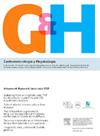Characterization of obstructive defecation from a structural and a functional perspective
IF 2.2
4区 医学
Q3 GASTROENTEROLOGY & HEPATOLOGY
引用次数: 0
Abstract
Background/aims
Defecation disorders can occur as a consequence of functional or structural anorectal dysfunctions during voiding. The aims of this study is to assess the prevalence of structural (SDD) vs functional (FDD) defecation disorders among patients with clinical complaints of obstructive defecation (OD) and their relationship with patients’ expulsive capacity.
Patients and methods
Retrospective study of 588 patients with OD studied between 2012 and 2020 with evacuation defecography (ED), and anorectal manometry (ARM) in a subgroup of 294.
Results
90.3% patients were women, age was 58.5 ± 12.4 years. Most (83.7%) had SDD (43.7% rectocele, 45.3% prolapse, 19.3% enterocele, and 8.5% megarectum), all SDD being more prevalent in women except for megarectum. Functional assessments showed: (a) absence of rectification of anorectal angle in 51% of patients and poor pelvic descent in 31.6% at ED and (b) dyssynergic defecation in 89.9%, hypertonic IAS in 44%, and 33.3% rectal hyposensitivity, at ARM. Overall, 46.4% of patients were categorized as pure SDD, 37.3% a combination of SDD + FDD, and 16.3% as having pure FDD.
Rectal emptying was impaired in 66.2% of SDD, 71.3% of FDD and in 78% of patients with both (p = 0.017).
Conclusions
There was a high prevalence of SDD in middle-aged women with complaints of OD. Incomplete rectal emptying was more prevalent in FDD than in SDD although FDD and SDD frequently coexist. We recommend a stepwise therapeutic approach always starting with therapy directed to improve FDD and relaxation of striated pelvic floor muscles.
从结构和功能角度分析梗阻性排便的特征。
背景/目的:排便障碍可能是排便过程中功能性或结构性肛门直肠功能障碍的结果。本研究旨在评估临床主诉为排便受阻(OD)的患者中结构性(SDD)与功能性(FDD)排便障碍的患病率及其与患者排出能力的关系:对2012-2020年间的588名排便障碍患者进行回顾性研究,对其中的294名患者进行排空排便造影(ED)和肛门直肠测压(ARM):90.3%的患者为女性,年龄为(58.5±12.4)岁。大多数患者(83.7%)患有肛门直肠脱垂(43.7%为直肠陷凹,45.3%为脱垂,19.3%为肠陷凹,8.5%为巨直肠),除巨直肠外,其他肛门直肠脱垂均以女性居多。功能评估显示:a) 51% 的患者肛门直肠角不整齐,31.6% 的患者在 ED 时骨盆下降不畅;b) 89.9% 的患者排便困难,44% 的患者 IAS 张力过高,33.3% 的患者在 ARM 时直肠敏感度过低。总体而言,46.4% 的患者被归类为单纯 SDD,37.3% 合并 SDD+FDD,16.3% 为单纯 FDD。66.2% 的 SDD 患者、71.3% 的 FDD 患者以及 78% 的同时患有 SDD 和 FDD 的患者的直肠排空功能受到影响(P=0.017):结论:在主诉OD的中年女性中,SDD的发病率很高。尽管 FDD 和 SDD 经常同时存在,但 FDD 比 SDD 更容易出现直肠排空不完全。我们建议采取循序渐进的治疗方法,从改善 FDD 和放松骨盆底横纹肌开始。
本文章由计算机程序翻译,如有差异,请以英文原文为准。
求助全文
约1分钟内获得全文
求助全文
来源期刊

Gastroenterologia y hepatologia
GASTROENTEROLOGY & HEPATOLOGY-
CiteScore
1.50
自引率
10.50%
发文量
147
审稿时长
48 days
期刊介绍:
Gastroenterology and Hepatology is the first journal to cover the latest advances in pathology of the gastrointestinal tract, liver, pancreas, and bile ducts, making it an indispensable tool for gastroenterologists, hepatologists, internists and general practitioners.
 求助内容:
求助内容: 应助结果提醒方式:
应助结果提醒方式:


